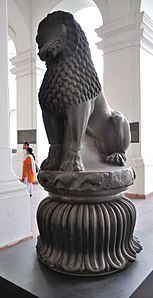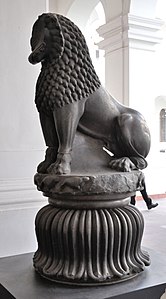Rampurva capitals
(Redirected from
Rampurva
)
 Original bull capital of Rampurva, one of the Pillars of Ashoka, now located in the Presidential Palace of Rashtrapati Bhavan, New Delhi. 3rd century BCE. | |
| Location | West Champaran district, Bihar, India. |
|---|---|
| Coordinates | 27°16′11.75″N 84°29′58.08″E / 27.2699306°N 84.4994667°E |
| Type | Settlement |
The Rampurva capitals are the
Kolkota, while the bull capital is located at the center of the porch of the Rashtrapati Bhavan
, the Indian Presidential Palace.
Buddhist significance
Gautama Buddha was in the region of Rampurva: "I believe that Kusīnagara, where the Buddha died may be ultimately found to the North of Bettiah, and in the line of the Açōka pillars which lead hither from Patna (Pāțaliputra)."[4] Modern scholarship, based on archaeological evidence, believes that the Buddha died in Kushinagar (Uttar Pradesh).[5][6][7]
Rampurava lion capital

The lion pillar is inscribed with the Major Pillar Edicts of the Edicts of Ashoka, Pillar Edicts I, II, III, IV, V, VI.[8]
Rampurva bull capital
The Rampurva bull capital is noted as one of the seven remaining animal capitals from the Pillars of Ashoka. It is composed of a lotiform base, with an abacus decorated with floral designs, and the realistic depiction of a zebu bull.
The abacus in particular displays a strong influence of
Diamond throne built by Ashoka at Bodh Gaya. These design likely originated in Greek and Near-Eastern arts.[10]
The bull is without inscriptions, presumably because its twin pillar, the Rampurava lion pillar already had them and therefore there was no need to repeat.
-
Rampurva pillar excavation 1877.
-
Remains of the pillars today.
-
Original Rampurva bull up the stairs of Rashtrapati Bhavan, New Delhi.
| Rampurva capitals | |
| Lion capital |
|
| Bull capital |
|
See also
Wikimedia Commons has media related to Rampurva.
References
- ^ "Rampurva". Encyclopædia Britannica. Retrieved 7 October 2014.
- ISBN 978-0143415749.
- ^ "Rampurva". Bihar Tourism. Retrieved 7 October 2014.
- Journal of the Asiatic Society of Bengal, 1896, p. 279.
- ISBN 978-92-1-120386-8.
- ISBN 978-0-19-517398-7.
- ISBN 978-0-495-57367-8.
- ^ a b c Buddhist architecture, Huu Phuoc Le, Grafikol, 2010 p.36-40
- ^ "Buddhist Architecture" by Huu Phuoc Le, Grafikol, 2010, p.40
- ^ "Buddhist Architecture" by Huu Phuoc Le, Grafikol, 2010, p.44 [1]
















